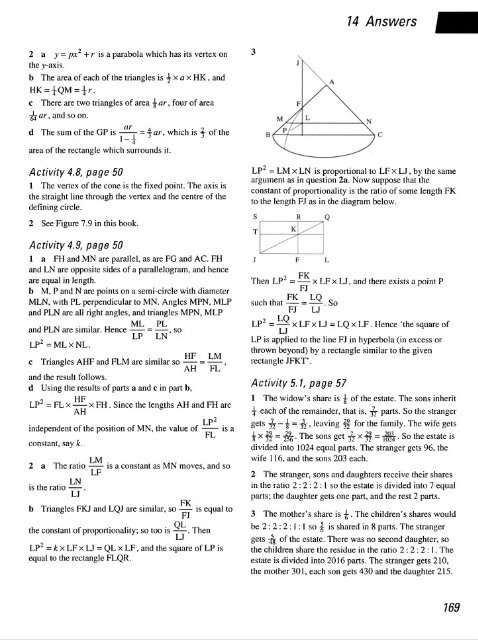history of mathematics - National STEM Centre
history of mathematics - National STEM Centre
history of mathematics - National STEM Centre
You also want an ePaper? Increase the reach of your titles
YUMPU automatically turns print PDFs into web optimized ePapers that Google loves.
2 a y = px 2 + r is a parabola which has its vertex on<br />
the >>-axis.<br />
b The area <strong>of</strong> each <strong>of</strong> the triangles is •£ x a x HK , and<br />
c There are two triangles <strong>of</strong> area ^ ar , four <strong>of</strong> area<br />
-, and so on.<br />
d The sum <strong>of</strong> the GP is -^- = j ar , which is f <strong>of</strong> the<br />
1~?<br />
area <strong>of</strong> the rectangle which surrounds it.<br />
Activity 4.8, page 50<br />
1 The vertex <strong>of</strong> the cone is the fixed point. The axis is<br />
the straight line through the vertex and the centre <strong>of</strong> the<br />
defining circle.<br />
2 See Figure 7.9 in this book.<br />
Activity 4.9, page 50<br />
1 a FH and MN are parallel, as are FG and AC. FH<br />
and LN are opposite sides <strong>of</strong> a parallelogram, and hence<br />
are equal in length.<br />
b M, P and N are points on a semi-circle with diameter<br />
MLN, with PL perpendicular to MN. Angles MPN, MLP<br />
and PLN are all right angles, and triangles MPN, MLP<br />
and PLN are similar. Hence -r^ = 7—, so<br />
LP LN<br />
LP 2 =MLxNL.<br />
c Triangles AHF and FLM are similar so<br />
HF LM<br />
and the result follows.<br />
d Using the results <strong>of</strong> parts a and c in part b,<br />
HF<br />
LP 2 = FL x —- x FH. Since the lengths AH and FH are<br />
AH<br />
LP 2<br />
independent <strong>of</strong> the position <strong>of</strong> MN, the value <strong>of</strong> _ is a<br />
FL<br />
constant, say k.<br />
LM<br />
2 a The ratio -— is a constant as MN moves, and so<br />
LF<br />
is the ratio LN<br />
U<br />
FK<br />
b Triangles FKJ and LQJ are similar, so —— is equal to<br />
FJ<br />
the constant <strong>of</strong> proportionality; so too is ——. Then<br />
LP 2 = k x LF x LJ = QL x LF, and the square <strong>of</strong> LP is<br />
equal to the rectangle FLQR.<br />
14 Answers<br />
LP = LM x LN is proportional to LF x LJ, by the same<br />
argument as in question 2a. Now suppose that the<br />
constant <strong>of</strong> proportionality is the ratio <strong>of</strong> some length FK<br />
to the length FJ as in the diagram below.<br />
Then LP 2 = —— x LF x LJ, and there exists a point P<br />
FJ V<br />
such that —= ^. So<br />
FJ LJ<br />
LP 2 = ^ x LF x LJ = LQ x LF. Hence 'the square <strong>of</strong><br />
LP is applied to the line FJ in hyperbola (in excess or<br />
thrown beyond) by a rectangle similar to the given<br />
rectangle JFKT.<br />
Activity 5.7, page 57<br />
1 The widow's share is -j <strong>of</strong> the estate. The sons inherit<br />
\ each <strong>of</strong> the remainder, that is, -fa parts. So the stranger<br />
gets -J2 - f = -J2 »leaving |f for the family. The wife gets<br />
¥ X 3J = ^- Tne sons get 37 x If = TC§: • So the estate is<br />
divided into 1024 equal parts. The stranger gets 96, the<br />
wife 116, and the sons 203 each.<br />
2 The stranger, sons and daughters receive their shares<br />
in the ratio 2:2:2:1 so the estate is divided into 7 equal<br />
parts; the daughter gets one part, and the rest 2 parts.<br />
3 The mother's share is ^. The children's shares would<br />
be 2 : 2 : 2 :1:1 so |- is shared in 8 parts. The stranger<br />
gets -fa <strong>of</strong> the estate. There was no second daughter, so<br />
the children share the residue in the ratio 2:2:2:1. The<br />
estate is divided into 2016 parts. The stranger gets 210,<br />
the mother 301, each son gets 430 and the daughter 215.<br />
169
















